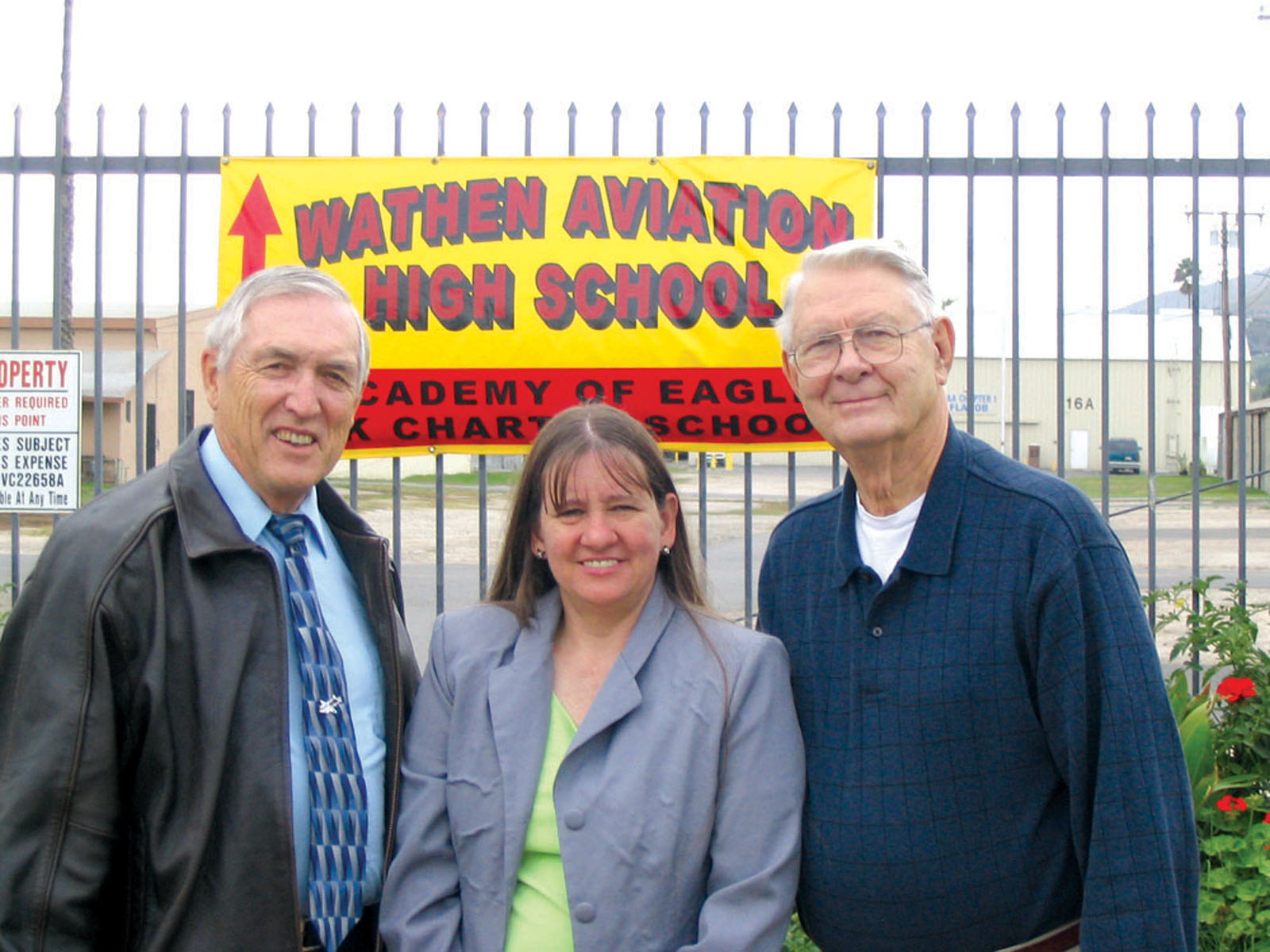By Shirley Lee
When Thomas W. Wathen retired as the chairman of the international security and detective firm known as Pinkerton’s in 1999, he had a special goal in mind. It was to devote his time and resources to charitable activities.
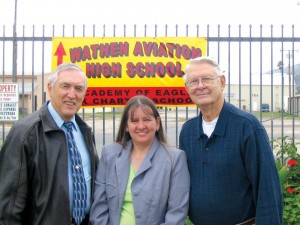
L to R: Wes Blasjo, Wathen Foundation High School principal and teacher; Dara DeVicariis, teacher and education specialist; and Dr. Arthur Peterson, president of the Wathen Foundation’s Air Academy.
As a boy, he worked at an airport in Indiana, washing airplanes, pumping gas and sweeping hangars. He got his private pilot’s license in 1958, owns several airplanes and has restored vintage Ercoupe monoplanes. Since he loved flying, it was natural for him to turn to aviation with his cause. What better purpose than to aid in the preservation of historic aircraft and help young people to learn about and appreciate the field of aviation?
The problem was finding a “campus” for his project. In 2000, he learned that Flabob Airport, near Riverside, Calif., was for sale. Unfortunately, it was already in the process of being purchased for a housing development. But there was still time for the owners to change their minds, and they did, once they learned of Wathen’s plans.
Since the airport was in need of repairs, he arranged for some of its structures to be removed and new ones built. The runways and taxiways needed paving, and the once popular café was restored. Currently, a $17-million improvement project–which will include an education building, conference center, library and industrial artisan headquarters–is in the planning stages.
Wathen Air Academy
Art Peterson, a former university professor, college president, aviation enthusiast, and a licensed pilot in his seventies, serves as president of the Thomas W. Wathen Air Academy, which offers aviation education programs for all ages. Kathy Rohm, community relations director, is his assistant. The two interact with school children in several ways.
They’ve contracted with schools in the Riverside School District, and arrangements have been made for fifth and sixth grade elementary school students to receive two classroom sessions–one on general aviation and one on navigation. These are followed by a visit to Flabob Airport for an introduction to various types of aircraft and hands-on building and flying of balsa gliders and hot air balloons.
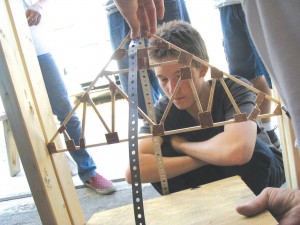
Doug DeVicariis anxiously looks on as his truss design is tested for its weight bearing capabilities.”
Middle school and high school students participate in five-day programs at Flabob Airport, featuring theory of flight, case studies, various types of hands-on learning and a visit to March Field Air Museum. Students are then taken on an actual flight and given the opportunity to fly the plane.
“Twelve to fifteen unpaid, experienced volunteers come in to help us,” explains Peterson.
Another hands-on learning program open to 14-18 year olds is a series of sequential learning programs with mentored participation in aircraft construction and repair. Participants whose work contributions earn them flight credits are rewarded with actual flight training.
Local area high schools and community colleges are offered aircraft industry-related internships through a variety of after-school programs, and the Wathen Foundation supports existing community college aviation programs. It also encourages and facilitates the emerging aviation-related high school programs that make possible exceptional achievement by students. Through the AeroScholars Program, sponsored by the Wathen Foundation, the Experimental Aircraft Association and Utah Valley State College, scholarships are offered for the college credit aviation education courses available on line, and also for the San Bernardino Community College A&P program.
In addition to projects for the young, a special program has been initiated for area seniors. Entitled Academy of Senior Pilots In REtirement (ASPIRE), participants, who need not be licensed pilots, focus on learning through reading clubs, film festivals and other related activities.
Though the EAA now has almost 1,000 chapters worldwide, EAA Chapter One, with more than 500 members, is still located at Flabob. The chapter offers a Young Eagles introduction to flight merit badge class once a month for Boy Scouts. The class culminates in an airplane flight during which the Young Eagle is allowed to take controls of the dual-control aircraft under the supervision of an FAA certified pilot. A similar program is offered to the general public for youths between the ages of 8 and 17.
A history worth recording
One reason that Flabob was the perfect spot for the Wathen Air Academy is its own personal history. One of the oldest airports in America, in the beginning it was known simply as Riverside Airport. In 1925, the property, near Mission Avenue and “in the shadow of Mt. Rubidoux,” was graded and cleared of weeds under the direction of the Riverside Commission of Aeronautics.
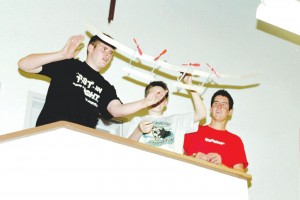
L to R: Chris Zukowski, Doug DeVicariis and Cameron Gagnon launch the Experimental Flabob Flyer. Experimentation and innovation are alive and well!
Roman Warren, a Montana cowboy-turned-barnstormer known as “the Cowboy Aviator,” first managed the airport. Because free-roving cattle grazed in the area, a corral was built. But it wasn’t for the cows. Instead, the airplanes were installed in it at night to keep the cows from eating their fabric coverings.
A hangar and other improvements were added and it soon became a busy place. In 1926, hoping to attract customers for sightseeing flights, Warren flew his World War I Thomas-Morse Scout under the low arch of the Rubidoux bridge before a crowd of people. The stunt made him nationally famous and he repeated it for the next several years at the Southern California Fair, using a wooden replica of the bridge. When Herbert Hoover beat Al Smith for the presidency, Warren took it upon himself to fly over Riverside with a lighted electric “H” under his airplane.
After Roman Warren left, the remaining pilots moved their planes downstream. There, a leftover Work Projects Administration tool shed offered some shelter. Later, it was to become Hangar One, with a lean-to that housed the first Flabob Café. (Still later, after replacing the tiny restaurant with a larger one, the lean-to became the workshop of “Professor” Art Scholl, who taught aeronautics for San Bernardino Valley College while flying in air shows and later became a movie pilot.)
With World War II looming, a Civil Air Patrol squadron was established there. In 1943, Flavio Madariaga and Bob Bogen purchased the airport. The partners were men with a purpose. Madariaga was a jack-of-all-trades, a pilot and a talented machinist. Bogen, an aeronautical engineer, owned a machine shop in Los Angeles. They determined to find a new location within 50 miles of Los Angeles that would have room for an airstrip and allow them to make aerial deliveries of supplies and parts. They chose that particular airport because they didn’t wish to settle in an area likely to become overcrowded.
Flavio Madariaga was noted for “scrounging” everything from airplanes to used buildings. It’s said that the unusual flavor of Flabob Airport–still present today–owes a lot to his own peculiar brand of wheeling and dealing. In order to purchase surplus buildings from a nearby Army camp, he once posed as a farmer, buying chickens and a donkey to prove the point. He died, along with his wife, when their twin-engine Piper PA-23-23, which he was flying, stalled, went out of control and crashed on their way to Las Vegas in l984.
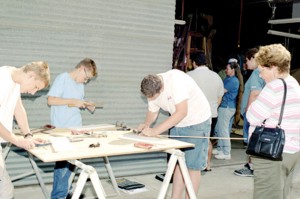
Grandmother Verla Horton looks on as Wathen students Jared Grumling, Ethan Little and Chris Zukowski build a miniature wooden airplane wing rib.
Flabob is noted for being one of the most prolific centers of aircraft design, construction and restoration. Many well-known figures in the field of aviation hung out at the airport over the years. Frank Tallman had hangars there, which he used for restoring military aircraft. He eventually joined with Paul Mantz in forming Tallmantz Aviation, which supplied Hollywood with aircraft and pilots. A stunt pilot himself, Tallman is noted for flying an airplane through a billboard in the 1963 movie, “It’s a Mad, Mad, Mad, Mad World.”
Clayton Stephens designed and built the Stephens Akro, the forerunner of the current aerobatic monoplanes, at Flabob. Lou Stolp developed many designs and refined his Stolp Starduster there. Ed Marquart created his Maverick, Lancer and Charger aircraft on the premises.
Jim Appleby produced a wide range of flying replicas of World War I aircraft there. Many of them were used in feature films. Ray Stits built and test-flew 15 of his 16 amateur-built designs at Flabob, including the world-famous “Sky Baby,” a biplane with a seven-foot, two-inch wingspan. He also founded the first EAA chapter there in 1953, and he developed his famous Stits Covering (Polyfiber), which is still located at Flabob. Now in his 80s, he still flies his 1975 Cessna 182.
Bill Turner built several replicas of great racers at Flabob, including the Miles & Atwood racer, the de Havilland Comet, Gee Bee Z and Roscoe Turner’s Meteor. He also worked with EAA Chapter One to restore Benny Howard’s “Pete.”
And now its own high school
In September 2005, Flabob Airport became home to Wathen Aviation High School, a tuition-free, state-funded public charter high school affiliated with Eagle Peak Charter Schools, a member of Western Association of Schools and Colleges, in partnership with the Thomas W. Wathen Foundation.
With word still getting around regarding this four-year high school’s existence, enrollment so far is a mere 18 boys, ranging from freshmen to seniors. It’s hoped that more students will become aware that it’s there and that it welcomes girls as well.
The school has several special advantages to offer. One aspect is that students are expected to be inspired by the fact that they’re spending their days at a working airport, in constant contact with aviation activities. The theory is that the airport’s aviation-rich environment bridges the gap between schoolwork and “real life.” Aviation will be integrated into science, math, government and leadership classes.
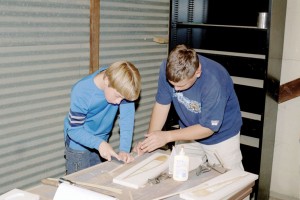
Tanner Richie and Jacob Mory concentrate on cutting and fitting the pieces for an airplane wing rib.
“An example of how we will do this is that our literature studies will feature the works of well-known aviation writers such as Gann, Lindberg, Faulkner and St. Exupéry,” said Wes Blasjo, a retired Army lieutenant colonel and pilot who serves as the school’s principal and as an instructor. “In history class, we’ll talk about why the airplane was invented in America and how aviation has influenced the world. We’ll have guest lectures by aviation experts and hands-on project learning with students participating in a real project or problem.”
The students spend Tuesday, Wednesday and Thursday in classes at the airport. Mondays are spent doing tutoring and remedial work. A hands-on aviation seminar is taught to the entire student body on Friday. This is where the practical and theoretical come together in a readily understandable form.
“I teach physics, biology, algebra, geometry, aviation seminar, the hands-on aviation, and PE,” explains Blasjo, who had plenty of teaching experience in charge of a large school in the Army Reserves and 34 years in public school education. “Right now, we’re playing football, but some days we do basketball. I want to get into a skill-building project where they’ll have to work on kicking and passing in football, and dribbling and shooting in basketball. If we get some girls here, we can get them involved in basketball, volleyball, riding bicycles and maybe some track.”
A second teacher, Dara DeVicariis, teaches English, history, health, career exploration and geography. Many family-oriented special events occur at Flabob, including antique airplane display days, aviation film festivals, Young Eagle flight rallies, and a Veterans Day observance.
In addition, Consolidated Aircraft Coatings, which is located there, is ready to provide internships in such fields as aircraft maintenance, aviation management and office administration. Those interested in a career as an airframe and/or powerplant technician can participate in a Federal Aviation Administration endorsed training program provided by San Bernardino Valley College at their Flabob facilities. Students can be co-enrolled in community college courses during their junior and senior years to obtain dual high school and college credit.
For more information on Wathen Aviation High School, contact Kathy Rohm at 951-683-2309, ext. 104, or visit [http://www.flabob.com/foundation.htm].











